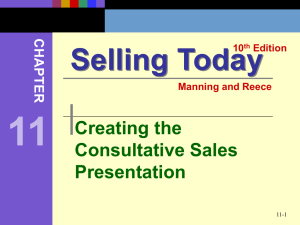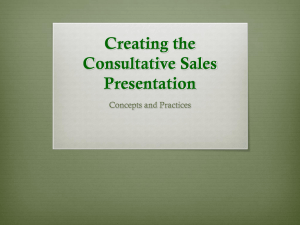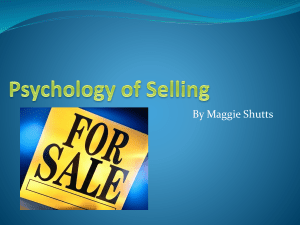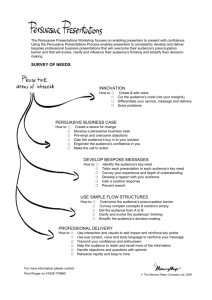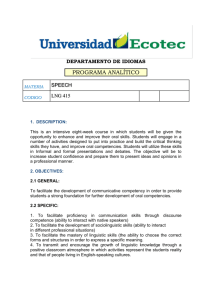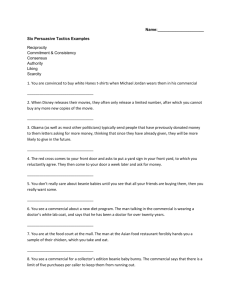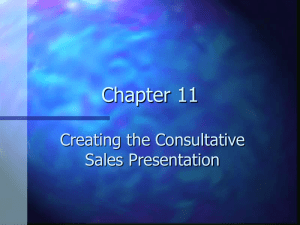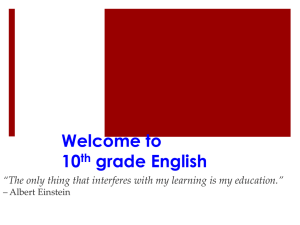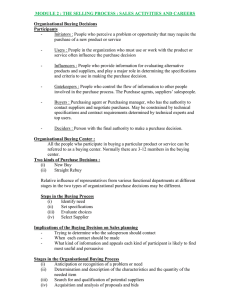CREATING THE CONSULTATIVE SALES PRESENTATION Selling
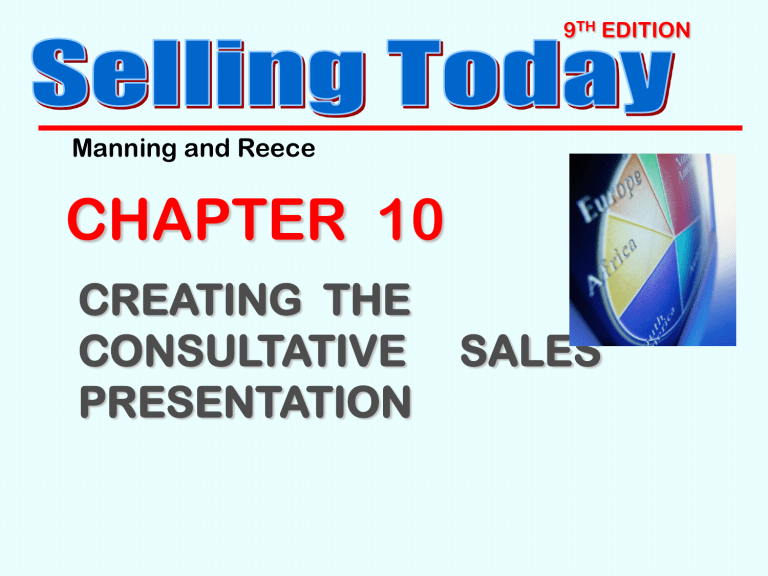
9 TH EDITION
Manning and Reece
CHAPTER 10
CREATING THE
CONSULTATIVE SALES
PRESENTATION
LEARNING OBJECTIVES
Describe characteristics of a consultative sales presentation
Explain how to determine prospect needs
Discuss use of questions to determine needs
Select products matching needs
List and describe three types of needsatisfaction strategies
Present general effectiveness guidelines
10-2
SIX-STEP PRESENTATION PLAN
1. APPROACH
2. PRESENTATION
3. DEMONSTRATION
4. NEGOTIATION
5. CLOSE
6. SERVICE
See details Figure 10.2.
10-3
FOUR-PART PRESENTATION PROCESS
NEED DISCOVERY
SELECTION OF PRODUCT/SOLUTION
NEED SATISFACTION
SERVICING THE SALE
See Figure 10.3.
10-4
NEED DISCOVERY
ASK RIGHT
QUESTIONS
LISTEN &
ACKNOWLEDGE
CUSTOMER
RESPONSE
ESTABLISH
BUYING
MOTIVE
10-5
VALUE OF QUESTIONING
”Questions provide one of the most effective ways to involve the prospect. Appropriate questions reduce tension and build trust in a selling situation because they communicate interest in the other person’s problem.”
10-6
TYPES OF QUESTIONS
Information-gathering
Probing
Confirmation
Summary--confirmation questions
See Table 10.1.
10-7
NEED DISCOVERY WORKSHEET
PRE-PLANNED QUESTIONS ARE OFTEN
USED TO IDENTIFY NEEDS
OPEN-ENDED QUESTIONS
“Tell me a little about your investment portfolio.”
“What are your current investment objectives?”
CLOSED-ENDED QUESTIONS
“Are you familiar with annuity investments?”
“Do you have a money market account?”
10-8
LISTENING AND ACKNOWLEDGING
Develop active listening skills
Focus full attention
Paraphrase customer’s meaning
Take notes
10-9
SELECTION OF PRODUCT
MATCH
BENEFITS &
MOTIVES
CONFIGURE
SOLUTION
See Figure 10.5.
MAKE THE
APPROPRIATE
RECOMMENDATION
10-10
MATCHING BENEFITS AND BUYING
MOTIVES
Buying based on needfulfillment
Buyers seek cluster of satisfactions
More needs met, more satisfactions provided, higher chance of sale
10-11
CONFIGURE A SOLUTION
Most salespeople have variety of products
Package solution from your array of products
10-12
APPROPRIATE RECOMMENDATIONS
THREE BASIC OPTIONS
Customer buys immediately
Salesperson makes need-satisfaction presentation
Recommend another source for product
10-13
NEED SATISFACTION PRESENTATION
SELECT
INFORMATIVE
SELECT
PERSUASIVE
See Figure 10.6.
SELECT
REMINDER
10-14
INFORMATIVE PRESENTATION
STRATEGY
Emphasizes facts
Works with complex or high priced products
Product stands on own merit
Stress clarity, directness, and simplicity
10-15
PERSUASIVE PRESENTATION
STRATEGY
Used when real customer need exists
Subtle seller transition from rational to emotional appeals
Requires training and experience to be effective
10-16
REMINDER PRESENTATION
STRATEGY
Also known as …
“reinforcement presentations”
Maintains product awareness
Good when working with repeat customers
10-17
PERSUASIVE VALUE-ADDED
PRESENTATIONS
Emphasize relationship
Sell benefits, obtain customer reactions
Minimize negative impact of change
Strongest appeal at start or end
Target emotional links
Use metaphors, stories, testimonials
10-18
GENERAL GUIDELINES VALUE-
ADDED PRESENTATIONS
Demonstration adds strength
Plan negotiating and closing methods
Plan customer service to add value
Keep presentation simple, concise
10-19
TIME USED BY SALESPERSON
Figure 10.7
10-20
REVIEW OF THREE STRATEGIES
Figure 10.6
10-21
TRANSACTIONAL BUYER
TRANSACTIONAL BUYERS
PRIMARILY INTERESTED IN PRICE
AND CONVENIENCE
--May have already done research, used Internet to gather product information
--Most understand what they need and when they need it
--Focus on price and delivery
Last slide Chapter 10.
10-22
